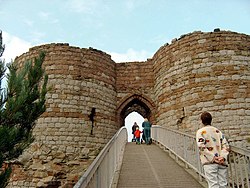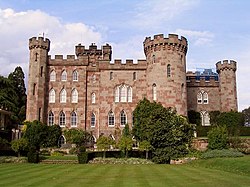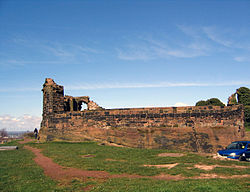Castles of England/Chesire
There are six castles of note in Chesire.
| Name |
Type |
Date |
Condition |
Ownership / Access |
Notes (Key) |
|---|---|---|---|---|---|
| Beeston Castle | Enclosure castle | 13–14th century | Ruins | Sited on crag high above Cheshire Plain, 19th century outer gatehouse. | |
| Chester Castle | Keep and bailey | 12th century | Fragment | Agricola tower sole feature of medieval castle to survive 18th century fire. | |
| Cholmondeley Castle | Neo-romantic castle | 1801–19 | Intact | Marquess of Cholmondeley |
Transformed into castle by Smirke, 1817–19. |
| Doddington Castle | Tower house | c.1403 | Substantially intact | Private | Also known as Delves Hall, Building At Risk. |
| Halton Castle | Castle | 13th century | Fragmentary remains | Duchy of Lancaster |
Commanding position, 13th century tower, 18th century courthouse, folly of c.1800. |
| Peckforton Castle | Neo-romantic castle | 1844–50 | Intact | Hotel | By Salvin, possibly the last serious fortified home built in Britain. |
Beeston Castle[edit | edit source]

Beeston Castle is in Beeston, Cheshire and is perched on a rocky sandstone crag 350 ft above the Cheshire Plain. It was built in the 1220s by Ranulf de Blondeville, 6th Earl of Chester, on his return from the Crusades. In 1237, Henry III took over the ownership of Beeston, and it was kept in good repair until the 16th century, when it was considered to be of no further military use, although it was pressed into service again in 1643, during the Civil War. The castle was slighted in 1646, in accordance with Cromwell's destruction order, to prevent its further use as a stronghold. During the 18th century the site was used as a quarry.
Unlike many other castles of the period, Beeston does not have a keep as its last line of defence. Instead the natural features of the land together with massive walls, strong gate houses, and carefully positioned towers made the baileys themselves the stronghold. The defences consisted of two parts. Firstly, an inner ward on the summit of the hill, with a sheer drop on three sides and a defensive ditch up to 30 ft deep in places cut into the rock on the fourth side. Secondly, an outer bailey was built on the lower slopes, with a massive gatehouse protected by a 16 ft wide and 10 ft deep ditch.
The outer bailey was roughly rectangular, with 6 ft thick walls faced in sandstone and infilled with rubble. The walls, parts of which still remain, contain a number of D-shaped towers, an innovation in English castles at that time. The towers allowed defenders to fire across the walls as well as forwards, and their open-backed design meant that they would not offer cover to any attackers who gained access to the outer bailey. The inner bailey was situated on the rocky summit at the western end of the crag.
To provide the castle's inhabitants with a supply of fresh water two wells were dug into the rock, one of them, at 370 ft deep, one of the deepest castle wells in England.
Chester Castle[edit | edit source]

Chester Castle is in the city of Chester and is sited at the south west extremity of the area bounded by the city walls. The castle stands on an eminence overlooking the River Dee. In the castle complex are the remaining parts of the medieval castle. The castle was built in 1070 by Hugh d'Avranches, 1st Earl of Chester. It is possible that it was built on the site of an earlier Saxon fortification but this has not been confirmed. The original structure would have been a motte and bailey castle with a wooden tower. In the 12th century the wooden tower was replaced by a square stone tower, the Flag Tower. During the same century the stone gateway to the inner bailey was built. This is now known as the Agricola Tower and on its first floor is the chapel of St Mary de Castro. In the 13th century, during the reign of Henry III, the walls of an outer bailey were built, the gateway in the Agricola Tower was blocked up and residential accommodation, including a Great Hall, was built along the south wall of the inner bailey. Later in the century, during the reign of Edward I, a new gateway to the outer bailey was built. This was flanked by two half-drum towers and had a drawbridge over a moat. Further additions to the castle at this time included individual chambers for the King and Queen, a new chapel and stables.
During the Civil War Chester was held by the Royalists. The castle was assaulted by Parliamentary forces in July 1643, and in January and April 1645. Together with the rest of the city, it was besieged between September 1645 and February 1646. Following the civil war the castle was used as a prison, a court and a tax office.
Cholmondeley Castle[edit | edit source]

Cholmondeley Castle is a country house in Cholmondeley, Cheshire. It is surrounded by a 7,500 acre estate. The present house was built between 1801 and 1804 by George Cholmondeley, 1st Marquess of Cholmondeley. It was designed by the local architect William Turner who was directed by the Marquess to give it the appearance of "an old Gothic Castle". In 1817–1819 turrets and towers were added to give it its present castle like appearance. An earlier house had been on the site dating from 1571. This was constructed of brick and timber framing and had been remodelled by Sir John Vanbrugh between 1713 and 1715.
Doddington Castle[edit | edit source]

Doddington Castle, sometimes known as Delves Hall, is a fortified structure in Doddington Park to the north of Doddington Hall, Cheshire. The fortified tower was built by Sir John Delves in 1364 on the site of a former moated manor house. The tower was initially free-standing and was probably intended as a place of refuge for the family. In the 17th century it was incorporated into a range of domestic buildings which were known as Doddington Hall. In the Civil War the hall became a garrison for the parliamentary forces. It was taken for the king by John Byron, 1st Baron Byron in January 1644 but retaken shortly after. The house was demolished around 1777 and replaced by the new Doddington Hall, leaving the tower as a landscape feature which was possibly used as a gazebo or a banqueting pavilion.
Halton Castle[edit | edit source]

Halton Castle is in the former village of Halton, Cheshire which is now part of the town of Runcorn. The castle is situated on the top of Halton Hill overlooking the village. It was the seat of the Barons of Halton from the 11th century until the 14th century and it then passed to the Duchy of Lancaster. It was besieged twice in the Civil War after which its structure deteriorated. In the 18th century a new courthouse was built on the site of the previous gatehouse. The castle lies in ruins apart from the courthouse which has been converted into a public house.
Following the Norman conquest, the Barony of Halton was established by Hugh d'Avranches, 1st Earl of Chester. The first baron to be appointed was Nigel of Cotentin and it is almost certain that he would have built a motte and bailey castle on the site, constructing it from wood, although the excavations in 1986–87 showed no evidence of a motte and bailey structure or of a timber tower or palisade. It is most probable that during the 12th century the wooden structure was replaced by a castle built from the local sandstone although no documentary evidence of this remains. Details of the building works are obscure but it has been suggested that John of Gaunt, the 14th baron, made alterations to the castle but this again has not been confirmed by documentary evidence. When the 15th baron, Henry Bolingbroke, ascended the throne as King Henry IV, the castle became the property of the Duchy of Lancaster.
The earliest documentary evidence of building work at Halton Castle shows that during the 15th century and into the 16th century it was regularly maintained. Between 1450 and 1457 a new gate tower was built. A survey of the Royal Palaces in 1609 suggests that by then the castle had fallen into disrepair. During the Tudor period it was used less as a fortress and more as a prison, an administrative centre, and a court of law.
At the outbreak of the Civil War the castle was garrisoned by the Royalists under the command of Captain Walter Primrose who had been appointed by Earl Rivers. It was besieged by Parliamentary forces under Sir William Brereton in 1643, and the Royalists eventually surrendered after several weeks. On hearing of the approach of superior Royalist forces led by Prince Rupert, the Parliamentarians abandoned the castle and it was held again for the Royalists under Colonel Fenwick. There was a second siege in 1644 but, as the fortunes of the Royalists declined elsewhere, they withdrew from Halton and the Parliamentarians under Sir William Brereton re-occupied the castle. In 1646 a "Council of War" was held in Warrington where it was decided that the defences of the castles at Halton and Beeston Castle were to be dismantled. In time this was achieved and Halton castle was to have no further military function. By 1650 the castle was said to be "very ruinous".
Peckforton Castle[edit | edit source]

Peckforton Castle is a country house built in the style of a medieval castle. It stands in woodland at the north end of Peckforton Hills one mile north west of the village of Peckforton, Cheshire. The house was built in the middle of the 19th century as a family home for John Tollemache, 1st Baron Tollemache, a wealthy Cheshire landowner, estate manager, and Member of Parliament. It was designed by Anthony Salvin in the Gothic style.

The castle was built between 1844 and 1850 by Dean and Son of Leftwich, with Joseph Cookson of Tarporley acting as clerk of works. Stone was obtained from a quarry about one mile to the west of the site, and a railway was built to carry the stone. The castle cost £60,000.
The castle is faced with red sandstone and has lead, asphalt and tile roofs. It is mainly in three storeys with a five-storey tower. The buildings are arranged around a ward with the principal accommodation on the north side. It is surrounded by a dry moat which is bridged at the gatehouse. To the west of the inner ward are the stables, the coach house, a rectangular bell tower and the kitchens and service area. To the north is the great hall range which consists of 18 bays. Behind the entrance to the hall is the circular main tower. At the east end of the gallery wing is the octagonal library tower. The outer walls of the castle have full-height slender turrets at the changes in direction. Corbel tables support part of the battlements. The walls contain arrow slots, and in the gatehouse is a garderobe. The flat roof has a crenellated parapet.
The castle had no formal garden, but at the bottom of the drive were kitchen gardens which included vegetable gardens, an orchard, extensive glass houses and a large orangery.